The miniature electrochemical CO sensor market is projected to expand from USD 12.4 million in 2025 to USD 21.2 million by 2035, growing at a CAGR of 5.5% and adding USD 8.8 million in total value. This trajectory represents a structural transition in gas detection technology, emphasizing miniaturization, energy efficiency, and integration flexibility within residential safety systems, portable devices, and wearable monitoring platforms. The first phase, from 2025 to 2030, will see the market advance to USD 16.2 million, adding USD 3.8 million (43%), supported by the rapid adoption of ultra-compact sensors (<15 mm diameter) favored for smart home detectors and consumer electronics integration. These miniature sensors will dominate production due to their compact design, low power consumption, and adaptability to constrained device geometries.
Between 2030 and 2035, market growth of USD 5 million (57%) will be driven by IoT-enabled modules, wireless CO detection systems, and multi-sensor fusion arrays that combine electrochemical detection with temperature, humidity, or VOC monitoring. Residential applications are projected to hold nearly 60% market share, supported by strong replacement cycles and the proliferation of portable CO detectors integrated with smart home ecosystems. Commercial installations will follow, driven by industrial monitoring requirements and stricter occupational safety compliance. Regionally, China (7.4% CAGR) and India (6.9%) lead growth through consumer electronics manufacturing expansion, while Germany (6.3%), Brazil (5.8%), and the United States (5.2%) sustain demand through advanced safety protocols and wearable technology adoption. Leading manufacturers such as City Technology, Alphasense, MEMBRAPOR, SGX Sensortech, and Figaro are refining nano-electrode structures, MEMS integration, and self-calibration algorithms to enhance accuracy and longevity in confined designs.

Where revenue comes from - now vs next (industry-level view)
The latter half (2030-2035) will witness continued growth from USD 16.2 million to USD 21.2 million, representing an addition of USD 5 million or 57% of the decade's expansion. This period will be defined by mass market penetration of nano-scale sensing technologies, integration with comprehensive IoT safety platforms, and seamless compatibility with existing wearable device infrastructure. The market trajectory signals fundamental shifts in how device manufacturers approach gas detection and sensor integration, with participants positioned to benefit from growing demand across multiple sensor sizes and application segments.
| Period | Primary Revenue Buckets | Share | Notes |
|---|---|---|---|
| Today | New sensor sales (residential, commercial detectors) | 49% | OEM integration-led, device miniaturization-driven purchases |
| Replacement sensors & calibration | 21% | Sensor lifecycle replacement, periodic recalibration | |
| Portable device integration | 19% | Wearable devices, handheld monitors | |
| Technical services & certification support | 11% | Calibration services, compliance validation | |
| Future (3-5 yrs) | IoT-enabled miniature sensors | 40-44% | Wireless integration, smart device connectivity |
| Ultra-miniature sensor modules | 26-30% | Wearable technology, consumer electronics integration | |
| Replacement & aftermarket | 13-16% | Sensor lifecycle management, maintenance services | |
| Commercial safety applications | 9-13% | Multi-sensor arrays, building automation systems | |
| Data analytics & monitoring services | 7-10% | Cloud-based tracking, exposure analytics platforms | |
| Professional services (calibration, testing, certification) | 4-7% | Technical validation support |
| Metric | Value |
|---|---|
| Market Value (2025) | USD 12.4 million |
| Market Forecast (2035) | USD 21.2 million |
| Growth Rate | 5.5% CAGR |
| Leading Technology | Diameter<15 mm |
| Primary Application | Residential Segment |
The market demonstrates strong fundamentals with ultra-miniature sensor systems capturing a dominant share through advanced size reduction capabilities and portable device optimization. Residential applications drive primary demand, supported by increasing safety awareness and portable CO detector requirements. Geographic expansion remains concentrated in developed markets with established safety regulation infrastructure, while emerging economies show accelerating adoption rates driven by consumer electronics initiatives and rising residential safety standards.
Primary Classification: The market segments by sensor size into diameter<15 mm, 15≤diameter<20 mm, and others, representing the evolution from standard miniature elements to ultra-compact detection solutions for comprehensive portable and wearable device integration optimization.
Secondary Classification: Application segmentation divides the market into residential and commercial categories, reflecting distinct requirements for gas detection, device integration, and safety monitoring standards.
Regional Classification: Geographic distribution covers North America, Latin America, Western Europe, Eastern Europe, East Asia, South Asia Pacific, and Middle East & Africa, with developed markets leading adoption while emerging economies show accelerating growth patterns driven by consumer safety device expansion programs.
The segmentation structure reveals technology progression from miniature sensor elements toward nano-scale detection systems with enhanced sensitivity and power efficiency capabilities, while application diversity spans from residential portable detectors to commercial wearable monitors requiring precise carbon monoxide detection solutions.

Market Position: Diameter<15 mm systems command the leading position in the miniature electrochemical CO sensor market with 50% market share through advanced ultra-miniaturization features, including superior space efficiency, integration versatility, and wearable device optimization that enable electronics manufacturers to achieve optimal sensing performance across diverse residential and commercial portable environments.
Value Drivers: The segment benefits from device manufacturer preference for ultra-compact sensing systems that provide reliable CO detection, minimal footprint requirements, and maximum design flexibility optimization without requiring significant device space allocation. Advanced design features enable ultra-low power consumption, rapid response characteristics, and integration with miniature electronics, where operational performance and size constraints represent critical product requirements.
Competitive Advantages: Diameter<15 mm systems differentiate through proven ultra-miniaturization capabilities, consistent detection characteristics, and integration with wearable and portable devices that enhance product effectiveness while maintaining optimal sensitivity standards suitable for diverse residential and commercial applications.
Key market characteristics:
15≤Diameter<20 mm systems maintain a market position in the miniature electrochemical CO sensor market due to their balanced performance properties and commercial application advantages. These systems appeal to manufacturers requiring enhanced sensitivity with competitive pricing for professional-grade portable monitoring applications. Market growth is driven by commercial safety expansion, emphasizing reliable detection solutions and operational performance through optimized sensor designs.
Other sensor size systems capture market share through specialized detection requirements in custom devices, legacy equipment, and specific product configurations. These applications demand flexible sensor systems capable of meeting unique requirements while providing effective CO detection capabilities and operational reliability.
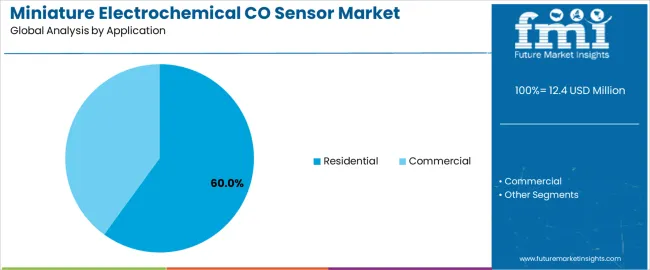
Market Context: Residential applications demonstrate the highest growth rate in the miniature electrochemical CO sensor market with 60.0% CAGR due to widespread adoption of compact CO detectors and increasing focus on home safety optimization, health protection improvement, and portable monitoring applications that maximize occupant safety while maintaining device portability standards.
Appeal Factors: Residential device manufacturers prioritize sensor compactness, battery longevity, and integration with portable detector designs that enable effective CO monitoring across household environments. The segment benefits from substantial consumer safety investment and residential protection programs that emphasize the acquisition of miniature CO detection systems for health protection and portable safety applications.
Growth Drivers: Home safety awareness programs incorporate miniature CO sensors as essential components for portable detector products, while consumer electronics integration increases demand for ultra-compact sensor capabilities that comply with safety standards and minimize carbon monoxide exposure risk.
Market Challenges: Varying price sensitivity and performance expectations may limit sensor standardization across different markets or product segments.
Application dynamics include:
Commercial applications capture market share through critical safety requirements in workplace monitoring, facility management systems, and professional safety equipment. These facilities demand reliable miniature sensor systems capable of operating in commercial environments while providing effective CO detection and operational durability capabilities.
Market Position: East Asia commands significant market position with 7.4% CAGR through rapid electronics manufacturing activity that drives demand for miniature gas detection solutions across residential and commercial safety applications.
Value Drivers: This region provides the ideal combination of consumer electronics capability and miniaturization expertise, meeting requirements for residential detector applications, wearable device integration, and portable monitoring installations without excessive technology complexity.
Growth Characteristics: The segment benefits from broad electronics manufacturing activity across device sectors, government safety initiatives, and established miniature sensor supply chains that support widespread adoption and production efficiency.
| Category | Factor | Impact | Why It Matters |
|---|---|---|---|
| Driver | Wearable technology growth & consumer electronics expansion | ★★★★★ | Increasing wearable devices and portable electronics create integration demand with size-constrained designs requiring ultra-miniature sensors. |
| Driver | Safety regulation enhancement & portable detector requirements | ★★★★★ | Expanding CO detection mandates drive miniature sensor adoption; portable compliance devices require compact sensing solutions. |
| Driver | IoT integration & connected safety ecosystems | ★★★★☆ | Smart home and building automation systems incorporate miniature sensors; wireless connectivity enables new monitoring applications. |
| Restraint | Technical complexity & miniaturization challenges | ★★★★☆ | Ultra-small sensor designs face performance trade-offs; maintaining sensitivity and stability in miniature form factors increases development costs. |
| Restraint | Limited sensor lifespan & replacement economics | ★★★☆☆ | Miniature electrochemical sensors have finite operational life; frequent replacement creates cost concerns for consumer applications. |
| Trend | Nano-scale fabrication & MEMS integration | ★★★★★ | Advanced manufacturing enables unprecedented miniaturization; nano-technology integration transforms sensor capabilities and application possibilities. |
| Trend | Multi-gas detection & sensor fusion | ★★★★☆ | Combining multiple miniature sensors in compact arrays; integrated multi-parameter monitoring drives premium segment growth. |
The miniature electrochemical CO sensor market demonstrates varied regional dynamics with Growth Leaders including China (7.4% growth rate) and India (6.9% growth rate) driving expansion through consumer electronics initiatives and safety device development. Steady Performers encompass Germany (6.3% growth rate), Brazil (5.8% growth rate), and developed regions, benefiting from established portable device markets and safety regulation adoption. Emerging Markets feature developing regions, where wearable technology initiatives and consumer safety support consistent growth patterns.
Regional synthesis reveals East Asian markets leading adoption through consumer electronics expansion and miniaturization expertise, while South Asian countries maintain strong growth supported by portable device manufacturing and safety awareness advancement. European and North American markets show moderate growth driven by sensor replacement and wearable device integration trends.
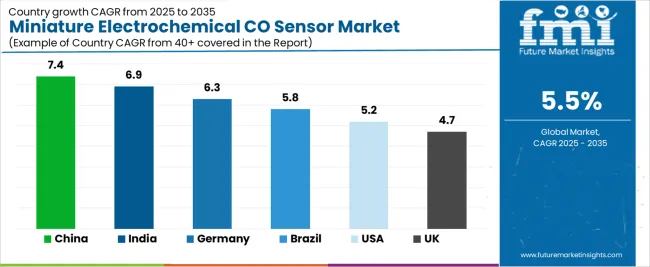
| Region/Country | 2025-2035 Growth | How to win | What to watch out |
|---|---|---|---|
| China | 7.4% | Lead with ultra-compact solutions | Manufacturing competition; rapid commoditization |
| India | 6.9% | Focus on consumer safety devices | Infrastructure gaps; price sensitivity |
| Germany | 6.3% | Offer premium miniature sensors | Certification costs; technical specifications |
| Brazil | 5.8% | Value-oriented integration support | Economic volatility; import dependencies |
| United States | 5.2% | Provide wearable device integration | Market fragmentation; consumer awareness |
| United Kingdom | 4.7% | Push IoT-enabled miniature sensors | Market maturity; regulatory evolution |

China establishes fastest market growth through aggressive consumer electronics manufacturing programs and comprehensive miniaturization technology development, integrating miniature electrochemical CO sensors as essential components in portable detector manufacturing and wearable device applications. The country's 7.4% growth rate reflects government initiatives promoting consumer safety and domestic sensor manufacturing capabilities that encourage the use of miniature CO detection systems in residential and commercial portable devices. Growth concentrates in major electronics hubs, including Shenzhen, Shanghai, and Guangzhou, where miniaturization technology development showcases integrated ultra-compact sensor systems that appeal to device manufacturers seeking advanced size reduction capabilities and cost optimization applications.
Chinese manufacturers are developing cost-effective miniature sensor solutions that combine domestic production advantages with performance features, including ultra-low power consumption and nano-scale designs. Distribution channels through electronics component suppliers and consumer device manufacturers expand market access, while government support for consumer safety adoption supports deployment across diverse residential and commercial segments.
Strategic Market Indicators:
In Mumbai, Delhi, and Bangalore, consumer device manufacturers and portable safety equipment suppliers are implementing miniature electrochemical CO sensors as essential components for compact detector manufacturing and personal safety applications, driven by increasing consumer electronics investment and safety awareness programs that emphasize the importance of portable carbon monoxide detection capabilities. The market holds a 6.9% growth rate, supported by growing consumer safety awareness initiatives and portable device adoption programs that promote miniature sensor integration for residential and commercial applications. Indian operators are adopting ultra-compact sensor systems that provide reliable detection performance and cost-effective features, particularly appealing in regions where product affordability and device portability represent critical product requirements.
Market expansion benefits from growing consumer electronics manufacturing capabilities and international technology partnerships that enable domestic production of miniature sensor systems for portable and wearable applications. Technology adoption follows patterns established in consumer electronics, where miniaturization and value drive procurement decisions and product integration.
Market Intelligence Brief:
Germany establishes technology leadership through comprehensive consumer safety programs and advanced electronics infrastructure development, integrating miniature electrochemical CO sensors across residential and commercial portable device applications. The country's 6.3% growth rate reflects established sensor technology industry relationships and mature miniaturization adoption that supports widespread use of premium ultra-compact CO detection systems in portable detector and wearable device facilities. Growth concentrates in major technology centers, including Baden-Württemberg, Bavaria, and North Rhine-Westphalia, where sensor technology showcases mature miniature deployment that appeals to device manufacturers seeking proven detection capabilities and certification compliance applications.
German equipment providers leverage established distribution networks and comprehensive technical capabilities, including calibration support and performance validation that create customer relationships and operational advantages. The market benefits from mature safety standards and device requirements that support miniature CO sensor use while encouraging technology advancement and miniaturization optimization.
Market Intelligence Brief:
Brazil's market expansion benefits from diverse consumer safety demand, including portable detector development in São Paulo and Rio de Janeiro, wearable device manufacturing, and government safety awareness programs that increasingly incorporate miniature sensor solutions for protection applications. The country maintains a 5.8% growth rate, driven by rising consumer electronics activity and increasing recognition of portable carbon monoxide detection benefits, including personal safety and home protection enhancement.
Market dynamics focus on cost-effective miniature sensor solutions that balance detection performance with affordability considerations important to Brazilian device manufacturers and consumers. Growing consumer electronics development creates continued demand for modern ultra-compact CO detection systems in new portable device infrastructure and consumer product deployment projects.
Strategic Market Considerations:
United States establishes market position through comprehensive consumer safety programs and mature portable device infrastructure development, integrating miniature electrochemical CO sensors across residential and commercial wearable applications. The country's 5.2% growth rate reflects established consumer device industry relationships and mature technology adoption that supports widespread use of miniature CO sensors in portable detector and personal safety facilities. Growth concentrates in major consumer markets, including California, Texas, and the Northeast, where safety awareness maintains steady miniature sensor demand that appeals to manufacturers seeking proven detection capabilities and consumer acceptance applications.
American device manufacturers leverage established distribution networks and comprehensive technical capabilities, including calibration services and consumer support that create customer advantages. The market benefits from mature consumer safety requirements and portable device standards that support miniature CO sensor demand while encouraging miniaturization improvements.
Market Intelligence Brief:
United Kingdom's market demonstrates mature miniature sensor deployment with operational effectiveness in residential detector applications and commercial wearable facilities through integration with existing portable device systems and consumer electronics infrastructure. The country maintains a 4.7% growth rate through sensor replacement demand and device upgrade programs. Urban regions, including London, Manchester, and Birmingham, showcase established installations where miniature CO sensors integrate with portable detectors and personal safety monitoring programs to optimize user protection.
British distributors prioritize product availability and technical support in miniature sensor supply operations, creating demand for reliable systems with proven performance, including calibration support and warranty coverage. The market benefits from established consumer safety regulations and a focus on detection reliability that provides steady sensor demand and compliance with protection standards.
Market Intelligence Brief:
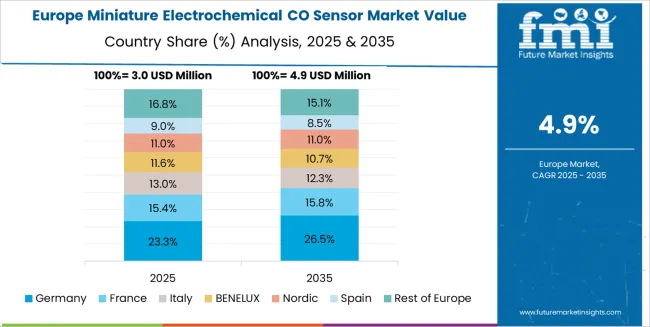
The miniature electrochemical CO sensor market in Europe is projected to grow from USD 4.3 million in 2025 to USD 7.2 million by 2035, registering a CAGR of 5.3% over the forecast period. Germany is expected to maintain its leadership position with a 36.8% market share in 2025, supported by its advanced consumer electronics infrastructure and major sensor technology centers including Baden-Württemberg and Bavaria.
United Kingdom follows with a 19.7% share in 2025, driven by comprehensive consumer safety programs and portable device deployment initiatives. France holds a 16.9% share through specialized residential applications and wearable technology requirements. Italy commands a 13.4% share, while Spain accounts for 9.1% in 2025. The rest of Europe region is anticipated to gain momentum, expanding its collective share from 4.1% to 4.8% by 2035, attributed to increasing miniature CO sensor adoption in Nordic countries and emerging Eastern European consumer device manufacturers implementing ultra-compact detection technology programs.
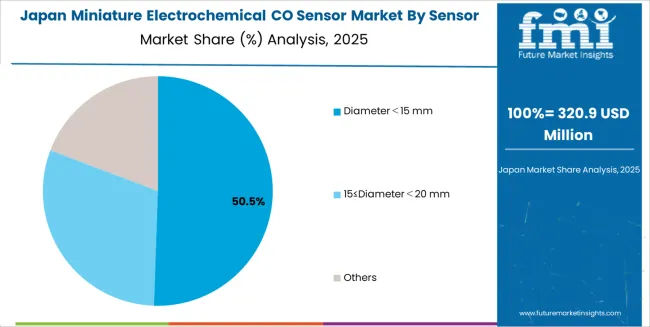
Japan's market exhibits sophisticated miniature sensor integration with documented operational effectiveness in portable detector manufacturing and wearable device applications through compatibility with existing consumer electronics systems and miniaturization infrastructure. The country maintains a 4.1% growth rate, leveraging engineering expertise in ultra-compact sensor technology and precision manufacturing. Electronics centers showcase premium installations where miniature CO sensors integrate with comprehensive consumer device platforms and safety monitoring systems to optimize detection operations and sensing precision.
Japanese manufacturers prioritize sensor quality and miniaturization excellence in electrochemical CO sensor development, creating demand for premium products with advanced features, including ultra-low power consumption and extended operational stability. The market benefits from established consumer electronics infrastructure and investment in miniaturization technology that provides long-term operational benefits and compliance with detection standards.
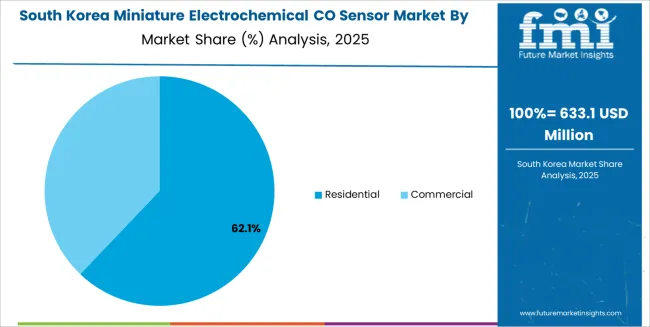
South Korea maintains a 3.9% growth rate through advanced consumer electronics programs and miniature sensor technology development initiatives that integrate ultra-compact CO detection systems across wearable device manufacturing, portable electronics, and personal safety applications. The country's device manufacturers implement miniature sensor solutions for product differentiation operations and consumer safety compliance, with technology adoption driven by miniaturization advancement and wearable technology integration programs. Market development focuses on high-performance miniature sensor systems with enhanced size reduction capabilities and wireless connectivity features for consumer applications.
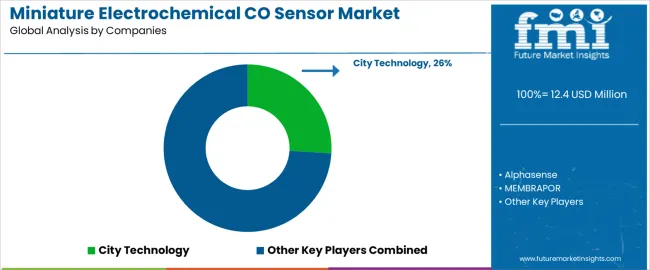
The miniature electrochemical CO sensor market operates with a concentrated structure where 10-15 specialized players maintain market presence, with the top 4-6 manufacturers holding approximately 58-65% market share by revenue. Market leadership is maintained through miniaturization expertise, sensor performance consistency, technical support capabilities, and manufacturing precision that enables reliable CO detection while maintaining ultra-compact dimensions across application segments.
Basic miniature electrochemical sensing functionality is becoming increasingly standardized, with entry-level ultra-compact CO sensors offering similar detection characteristics across manufacturers. However, margin opportunities exist in value-added features including nano-scale miniaturization capabilities, IoT connectivity integration, ultra-low power consumption optimization, and comprehensive OEM integration support services that extend beyond standard sensor supply.
Established gas sensor manufacturers compete through proven miniaturization capabilities and extensive certification portfolios, while specialized micro-sensor companies leverage advanced fabrication expertise and application engineering capabilities. The competitive environment increasingly emphasizes extreme size reduction capabilities, power efficiency optimization, and wearable device integration readiness rather than purely sensitivity-based differentiation. Technical support quality for OEM integration and calibration service availability represent critical competitive advantages, with established miniaturization infrastructure creating barriers to entry for new participants without nano-scale fabrication capabilities.
Technology innovation focuses on MEMS integration, advanced nano-electrode designs, wireless communication capabilities, and self-calibration systems. However, fundamental electrochemical CO sensing principles remain relatively stable, with competitive differentiation emerging through extreme miniaturization achievement, power consumption reduction, and customer support quality. The market experiences moderate pricing pressure from Asian manufacturers in standard miniature segments, while ultra-compact and IoT-enabled categories maintain premium positioning through proven reliability in size-constrained applications and comprehensive technical documentation.
| Stakeholder | What they actually control | Typical strengths | Typical blind spots |
|---|---|---|---|
| Global miniature sensor manufacturers | Miniaturization technology, certification portfolio, production precision | Advanced fabrication, proven reliability, technical resources | Rapid customization; emerging wearable market dynamics |
| Micro-sensor specialists | Ultra-compact expertise, nano-fabrication, integration engineering | Technical depth, extreme miniaturization, performance optimization | Consumer market access; distribution scale |
| Consumer device manufacturers | OEM integration, product specification, end-user channels | Application understanding, volume leverage, consumer insights | Sensor technology depth; alternative supplier development |
| Regional distributors | Channel access, technical support, integration services | Local presence, application guidance, customer proximity | Advanced miniaturization capability; manufacturing scale |
| Item | Value |
|---|---|
| Quantitative Units | USD 12.4 million |
| Sensor Size | Diameter<15 mm, 15≤Diameter<20 mm, Others |
| Application | Residential, Commercial |
| Regions Covered | North America, Latin America, Western Europe, Eastern Europe, East Asia, South Asia Pacific, Middle East & Africa |
| Countries Covered | United States, China, Germany, India, United Kingdom, Japan, Brazil, and 20+ additional countries |
| Key Companies Profiled | City Technology, Alphasense, MEMBRAPOR, SGX Sensortech, Figaro, Draeger, Winsen, Dart, GE, Nemoto |
| Additional Attributes | Dollar sales by sensor size and application categories, regional adoption trends across East Asia, South Asia Pacific, and Western Europe, competitive landscape with miniature sensor manufacturers and portable device suppliers, device manufacturer preferences for ultra-miniaturization and detection reliability, integration with consumer electronics and wearable monitoring platforms, innovations in miniature electrochemical sensing technology and nano-scale enhancement, and development of advanced ultra-compact CO detection solutions with enhanced performance and portable device optimization capabilities. |
The global miniature electrochemical co sensor market is estimated to be valued at USD 12.4 million in 2025.
The market size for the miniature electrochemical co sensor market is projected to reach USD 21.2 million by 2035.
The miniature electrochemical co sensor market is expected to grow at a 5.5% CAGR between 2025 and 2035.
The key product types in miniature electrochemical co sensor market are diameter<15 mm, 15≤diameter<20 mm and others.
In terms of application, residential segment to command 60.0% share in the miniature electrochemical co sensor market in 2025.






Full Research Suite comprises of:
Market outlook & trends analysis
Interviews & case studies
Strategic recommendations
Vendor profiles & capabilities analysis
5-year forecasts
8 regions and 60+ country-level data splits
Market segment data splits
12 months of continuous data updates
DELIVERED AS:
PDF EXCEL ONLINE
Miniature Ball Bearings Market Analysis by Type, End-use and Region: Forecast for 2025 to 2035
Miniature Duplex Connectors Market Size and Share Forecast Outlook 2025 to 2035
Micro-Miniature Co-axial Adapter Market Size and Share Forecast Outlook 2025 to 2035
Spirits Miniatures Market Analysis by Capacity, Material, End Use, and Region through 2035
Evacuated Miniature Crystal Oscillator (EMXO) Market Forecast and Outlook 2025 to 2035
Demand for Miniature Duplex Connectors in USA Size and Share Forecast Outlook 2025 to 2035
Stainless Steel Miniature Screw Market Size and Share Forecast Outlook 2025 to 2035
Electrochemical CO Sensor for Portable Device Market Size and Share Forecast Outlook 2025 to 2035
Electrochemical Gas Sensor for CO Market Size and Share Forecast Outlook 2025 to 2035
Bioelectrochemical Systems For Wastewater Treatment Market Size and Share Forecast Outlook 2025 to 2035
Multichannel Electrochemical Workstation Market Size and Share Forecast Outlook 2025 to 2035
Consumer Grade Electrochemical CO Sensor Market Size and Share Forecast Outlook 2025 to 2035
Demand for Multichannel Electrochemical Workstations in UK Size and Share Forecast Outlook 2025 to 2035
Sensor Data Analytics Market Size and Share Forecast Outlook 2025 to 2035
Sensor Testing Market Forecast Outlook 2025 to 2035
Sensor Fusion Market Size and Share Forecast Outlook 2025 to 2035
Sensor Development Kit Market Size and Share Forecast Outlook 2025 to 2035
Sensory Modifier Market Size and Share Forecast Outlook 2025 to 2035
Sensor Bearings Market Insights - Growth & Forecast 2025 to 2035
Sensor Hub Market Analysis - Growth, Demand & Forecast 2025 to 2035

Thank you!
You will receive an email from our Business Development Manager. Please be sure to check your SPAM/JUNK folder too.
Chat With
MaRIA